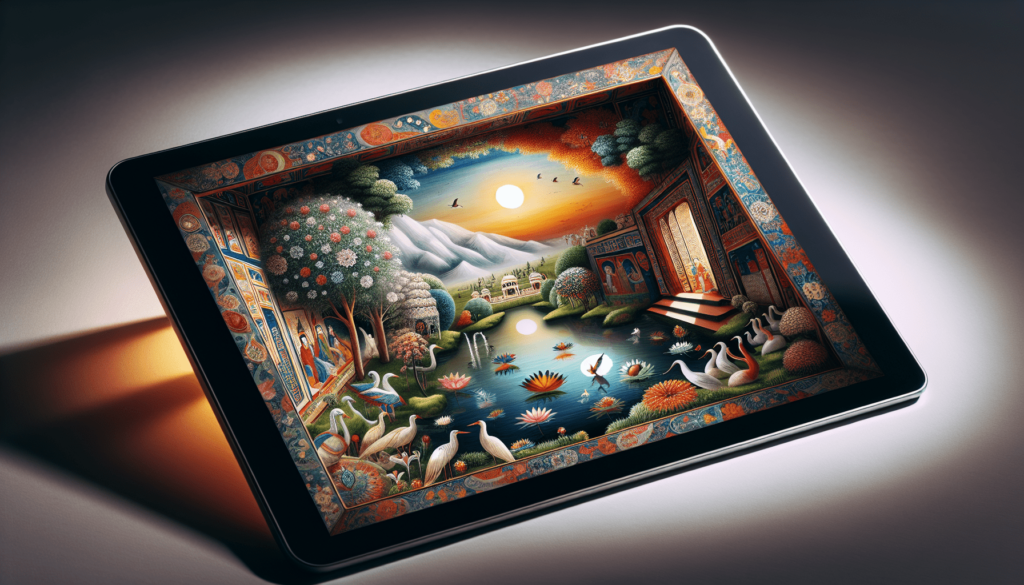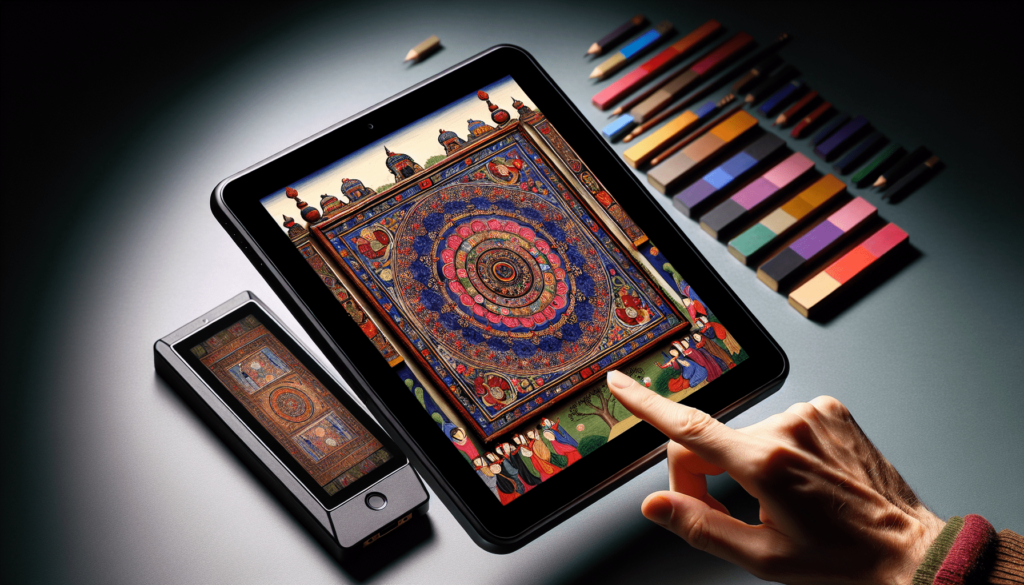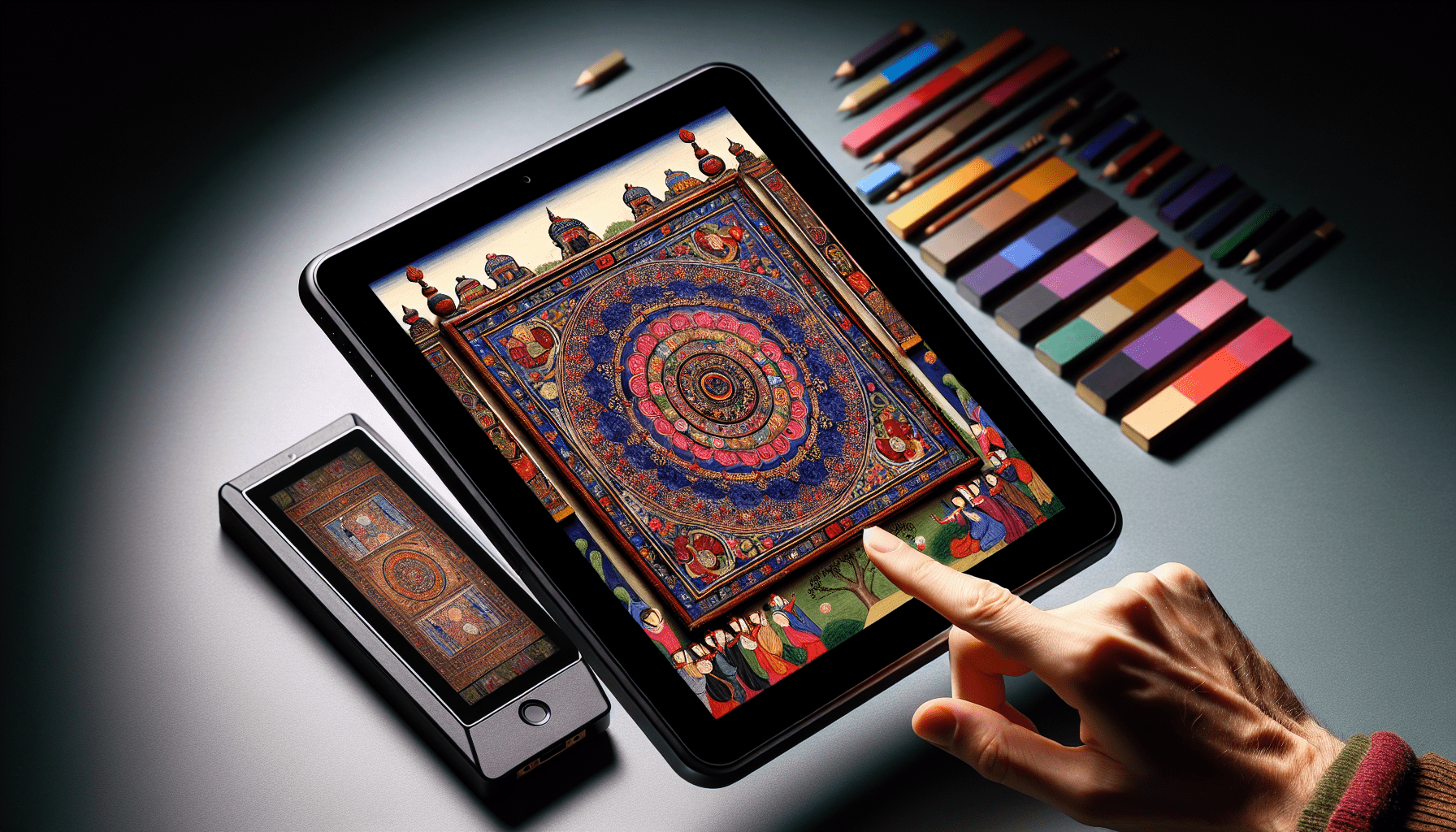In the world of art, where techniques constantly evolve and innovation is valued, one tradition that has stood the test of time is traditional miniature painting. With its intricate details and vibrant colors, this art form has captivated audiences for centuries. However, in an effort to bridge the gap between the past and the present, contemporary artists have begun combining modern techniques with this ancient practice. By infusing traditional miniature painting with contemporary elements, a new form of art is emerging, one that breathes fresh life into an age-old tradition. Miniature painting has a long and rich history, dating back centuries. Traditionally, miniatures were created using delicate brushes and exquisite attention to detail. However, with the advent of digital tools, artists are now able to explore new techniques and possibilities in the world of miniature painting. In this article, we will delve into the various digital tools and methods that can be used to enhance and expand the art of miniature painting.

Digital painting software
Digital painting software has revolutionized the way artists approach their craft. With programs such as Adobe Photoshop or Corel Painter, artists can now create intricate and detailed miniature paintings on their computers. These software tools offer a wide range of brushes and textures that mimic traditional mediums, allowing artists to experiment and explore different styles and techniques. Additionally, digital painting software provides the advantage of unlimited undo and layers, making it easier to correct mistakes and add depth to the artwork.
Tablets and styluses
While digital painting can be done using a mouse or trackpad, using a tablet and stylus offers a more natural and intuitive experience. Tablets, such as the Wacom Intuos or iPad, provide a pressure-sensitive surface that allows artists to vary the thickness and opacity of their brush strokes, just like in traditional painting. The stylus becomes an extension of the artist’s hand, enabling precise control and allowing for the creation of intricate details. This combination of tablets and styluses brings a tactile element back into the digital realm, making it a perfect tool for miniature painting.
Photoshop techniques
Photoshop, a versatile and powerful software, opens up a whole world of possibilities for miniature painters. The program offers a wide range of tools and features that can be used to enhance and embellish traditional miniature paintings. Techniques such as digital glazing, where transparent layers of color are built up to create depth and richness, can be easily accomplished in Photoshop. Additionally, artists can experiment with filters, blending modes, and adjustment layers to create unique effects and textures, giving their miniature paintings a modern and contemporary twist.
Incorporating Mixed Media
Mixing different materials and techniques can add depth and interest to miniature paintings, creating unique and dynamic artworks. Collage techniques, for example, involve layering cut-out images or papers onto the miniature painting, adding texture and dimension. This can be done using traditional materials, such as magazine clippings or textured papers, or with digital imagery printed onto paper and incorporated into the artwork.
Layering with different materials is another way to add depth and interest to miniature paintings. Artists can experiment with using materials such as fabric, lace, or even dried flowers, to create texture and contrast. These materials can be adhered to the painting using traditional glue or, for a more unique twist, using digital print transfer techniques. The combination of textures and mediums brings a tactile and visual richness to the miniature artwork.
Creating texture with fabric or paper
For those looking to add a tactile element to their miniature paintings, incorporating fabric or paper into the artwork can provide an interesting and unique surface. By stretching fabric or adhering paper onto a wooden board, artists can create a textured surface that adds depth and dimension to their paintings. The fabric or paper can then be painted on, allowing the paint to interact with the texture and enhancing the overall visual effect. This technique is especially effective when painting landscapes or objects that benefit from a textured background.
Experimenting with Colors and Styles
One of the advantages of digital tools is the ability to experiment with colors and styles that might be difficult or time-consuming to achieve with traditional methods. By using digital brushes and palettes, artists can explore vibrant and unconventional color combinations in their miniature paintings. This adds a contemporary and unique flair to the artwork, making it stand out and catch the viewer’s attention.
Blending traditional and contemporary styles is another way to create visually striking miniature paintings. By combining the delicacy and precision of traditional miniature painting techniques with bold and modern elements, artists can create artworks that bridge the gap between the past and the present. This juxtaposition of styles adds depth and complexity to the artwork, allowing the artist’s personal style to shine through.
Exploring Different Surfaces
While miniature paintings are typically done on paper or canvas, artists can push the boundaries by experimenting with unconventional surfaces. Painting on wood or metal, for example, adds an element of surprise and uniqueness to the artwork. The natural textures and grains of these materials can provide an interesting backdrop for the miniature painting, enhancing its overall aesthetic. Artists can also explore painting on textured surfaces such as stones or ceramics, allowing the texture to influence the final result.
Using textured surfaces can also have a profound impact on the overall look and feel of a miniature painting. By intentionally choosing surfaces with ridges, bumps, or grooves, artists can create a three-dimensional effect that adds depth and dimension to the artwork. This technique works particularly well when painting subjects such as landscapes or still-life scenes, adding a tactile element that draws the viewer into the miniature world.
Combining Miniature Painting with 3D Printing
The advent of 3D printing technology has opened up new possibilities for miniature painters. Artists can now design and 3D print custom miniatures, adding intricate details that would be challenging to achieve through traditional means. With the help of modeling software and a 3D printer, artists can bring their imagination to life, creating unique and visually stunning miniatures. These miniatures can then be painted using traditional techniques, adding depth and personality to the printed object.
Designing and printing custom miniatures
Designing and printing custom miniatures allows artists to have full creative control over their artworks. By using modeling software, artists can design their miniature, paying attention to every tiny detail. Once the design is complete, it can be sent to a 3D printer, which will bring the miniature to life layer by layer. The resulting object can then be delicately painted, showcasing the artist’s skill and blending traditional painting techniques with modern technology.
Adding intricate details with 3D printing
One of the advantages of 3D printing is the ability to add intricate and detailed elements to miniatures that would be challenging to create by hand. The precision of the technology allows for the creation of intricate patterns, textures, and even movable parts. Artists can take advantage of this by designing miniatures that incorporate these elements, further enhancing the visual appeal and storytelling capability of their artworks. Whether it’s a tiny door that opens or a delicate lattice design, 3D printing enables artists to push the boundaries of miniature painting.
Incorporating Miniatures into Digital Art
The world of digital art offers countless opportunities for artists to incorporate miniature paintings into their creations. By creating digital illustrations that feature miniature paintings as focal points or backgrounds, artists can combine the delicacy and precision of traditional techniques with the limitless possibilities of digital art. This blending of mediums gives artists the flexibility to experiment with different styles, colors, and textures, resulting in visually captivating artworks.
Creating digital illustrations featuring miniature paintings
Creating digital illustrations featuring miniature paintings allows artists to explore new dimensions and perspectives. By digitally painting the miniature, artists can manipulate scale, perspective, and lighting in ways that would be difficult to achieve with traditional methods. This opens up a new world of storytelling possibilities, allowing artists to create narratives and evoke emotions through their artworks. The combination of traditional and digital elements adds depth and richness to the artwork, making it visually engaging and thought-provoking.
Blending traditional and digital techniques
Blending traditional and digital techniques is a powerful way to create unique and visually striking artworks. By scanning or photographing a traditional miniature painting and importing it into digital software, artists can manipulate, enhance, and experiment with the artwork in ways that would be challenging or impractical to achieve by hand. Through the use of digital brushes, filters, and layers, artists can add depth, texture, and special effects, taking their miniature paintings to new heights. This combination of old and new techniques results in artworks that are rooted in tradition but embrace the possibilities of the digital age.
Adding Animation to Miniature Paintings
Animation adds a dynamic and captivating element to miniature paintings, bringing them to life in unexpected ways. Through stop-motion techniques, artists can create animated miniatures by photographing a series of incremental changes to the painting and then stitching them together to form a fluid sequence of motion. This method allows the artist to add movement and narrative to their miniature paintings, enhancing the overall storytelling capability of the artwork.
Creating animated miniatures with stop-motion techniques
Creating animated miniatures with stop-motion techniques requires patience and attention to detail. Artists have to carefully plan and set up each frame, making incremental changes to the miniature painting with each photograph. Once the sequence is complete, the photographs are combined using software to create a seamless animation. This combination of traditional painting and animation creates an enchanting and mesmerizing experience for the viewer, transforming static artworks into living and breathing creations.

Using augmented reality to bring miniatures to life
Augmented reality (AR) offers a fascinating way to bring miniature paintings to life. By using a smartphone or tablet with AR capabilities, viewers can experience the miniature painting in an interactive and immersive way. Through the screen, the miniature can be transformed into a three-dimensional object or even a moving character, allowing the viewer to explore the artwork from different angles and perspectives. This merging of physical and digital worlds adds an engaging and interactive element to miniature paintings, creating a unique and memorable experience.
Creating Interactive Miniature Artwork
Interactive miniature paintings take the art form to a whole new level by incorporating sensors and electronics. By embedding sensors into the artwork, artists can create interactive installations that respond to the viewer’s presence or touch. These sensors can trigger lights, sounds, or even movement, transforming the miniature painting into a multi-sensory experience. The combination of traditional painting techniques and interactive elements creates a truly immersive and engaging artwork, blurring the line between art and technology.
Incorporating sensors and electronics into miniature paintings
Incorporating sensors and electronics into miniature paintings requires a combination of artistic skill and technical know-how. Artists have to carefully plan and design their artwork, considering how the sensors will be integrated and what kind of interaction they will trigger. Through the use of microcontrollers, such as Arduino or Raspberry Pi, artists can bring their miniature paintings to life, creating a truly interactive experience for the viewer. This fusion of traditional techniques and cutting-edge technology opens up a world of possibilities for miniature painters.
Creating interactive installations
Creating interactive installations allows artists to transform their miniature paintings into immersive environments. By incorporating multiple miniature paintings, sensors, and other interactive elements, artists can create an entire world for viewers to explore and interact with. These installations can be displayed in galleries or public spaces, inviting viewers to become an active part of the artwork. Through the combination of traditional miniature painting techniques and interactive elements, artists can create memorable and transformative experiences that blur the boundaries between art and audience.
Exploring Miniature Painting in Street Art
Street art has long been a platform for artists to showcase their creativity and engage with the public. The addition of miniature paintings to street art installations adds a unique and unexpected element to the urban environment. Whether it’s hidden in plain sight or tucked away in unexpected corners, miniature paintings can surprise and delight passersby, inviting them to take a closer look and engage with the artwork.
Miniature paintings as part of street art installations
Incorporating miniature paintings into street art installations offers a fresh and intriguing perspective. Artists can use miniature paintings to tell stories or convey messages, serving as an intimate and personal counterpoint to the larger street art mural. The scale and detail of the paintings draw the viewer in, encouraging them to pause and reflect amidst the hustle and bustle of the city. This fusion of miniature painting and street art creates a visually captivating and thought-provoking experience for the viewer.
Combining traditional and contemporary street art techniques
Combining traditional and contemporary street art techniques provides artists with a unique canvas for self-expression. By blending the delicacy and precision of miniature painting techniques with the boldness and scale of street art, artists can create visually striking artworks that challenge traditional notions of art and public space. This fusion of styles and techniques adds depth and complexity to the artwork, inviting viewers to engage with the artwork on multiple levels and consider the intersection of tradition and modernity.
Preserving Traditional Techniques in Modern Miniature Painting
While modern techniques have expanded the possibilities of miniature painting, it is important to preserve and honor traditional techniques that have been passed down through generations. Learning and practicing traditional miniature painting techniques allows artists to connect with the rich history and heritage of the art form. It also provides a solid foundation of skills and knowledge that can be built upon and expanded with modern mediums and techniques.
Learning and practicing traditional miniature painting techniques
Learning and practicing traditional miniature painting techniques requires dedication, patience, and a willingness to learn from masters of the craft. It is important to study the traditional methods, understand the materials used, and practice the delicate brushwork that characterizes miniature painting. By immersing oneself in the traditional techniques, artists can gain a deeper appreciation for the art form and develop their own unique style and voice.
Blending traditional techniques with modern mediums
Blending traditional techniques with modern mediums allows artists to push the boundaries of miniature painting while still honoring its roots. By incorporating new materials such as digital brushes or 3D printing, artists can add depth, texture, and intricacy to their traditional miniature paintings. This fusion of old and new techniques creates visually compelling artworks that bridge the gap between tradition and modernity. It also ensures that the art of miniature painting continues to evolve and thrive in the digital age.
In conclusion, the world of miniature painting has been significantly transformed by the introduction of digital tools and modern techniques. Artists now have access to a wide range of software, tablets, and 3D printing technologies that expand the possibilities of their craft. By incorporating mixed media, experimenting with colors and styles, exploring different surfaces, and blending traditional and digital techniques, artists can create unique and visually captivating miniature paintings. Whether it is through animation, interactive installations, street art, or the preservation of traditional techniques, miniature painting continues to evolve and thrive, bridging the gap between traditional art forms and the digital age. So grab your brushes, tablets, and 3D printers and embark on your own miniature painting journey, exploring the endless possibilities that modern technology has to offer.

Leave a Reply